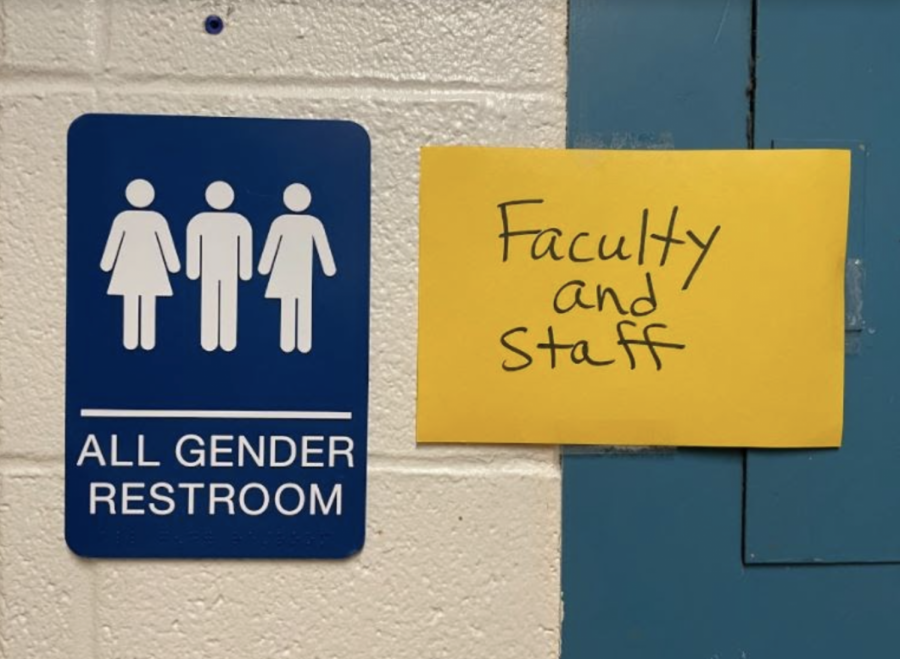We Need Accessible All-Gender Bathrooms
December 15, 2021
The 2021-2022 school year brought many changes and challenges for South’s community: students returned, hallways busied, club membership surged. But a more inconspicuous change took place as well: the quiet introduction of all-gender bathrooms scattered throughout the building. These bathrooms, originally single-user faculty restrooms, appeared without fanfare, noticed by only a few students, and used by even fewer. When I first saw these bathrooms, I thought them to be a step in the right direction towards the inclusion of trans and nonbinary students in our school. After a year on Zoom in which many people displayed their preferred pronouns, I figured the addition of all-gender bathrooms was a continuation of this trend—an overdue acknowledgment of a group that has been sidelined for too long. But a couple of weeks later, another sign appeared next to the one declaring the restroom open to all: “For faculty use only.”
The creation of all-gender restrooms has been many years in the making. As recently as March of 2021, New York State passed a law requiring all schools to convert their single-user bathrooms into all-gender ones. “In New York State, this discussion first came about seven years ago,” said Principal Dr. Christopher Gitz, “but it was not so much [about] all-gender as much as it was transgender guidelines and protocols for transgender students.” Seven years ago, the United States Department of Education extended Title IX, a law that protects students from gender- and sex-based discrimination, to include trans and nonbinary students. This legislation kickstarted the conversation in the New York State Legislature, which eventually trickled its way down to the local level.
Prior to this legislation, all accommodations of trans and nonbinary students occurred on an individual basis, without any school-wide discussions or changes to policy. “Since I’ve been working here, we’ve had students inquire about transgender facilities because they were identifying as a transgender person, and we’ve met with them individually and asked what they felt comfortable doing,” said Dr. Gitz.
Bathrooms have always been a battleground for the cause of trans rights—a favorite last stand for trans-exclusionary talking heads—and a source of eternal strife for trans people. Men’s and women’s bathrooms leave a trans person with an even crueler binary: “Do I get beaten up, or do I get yelled at?”
Trans and nonbinary youth are one of the most vulnerable groups in this country. The trans suicide rate is extremely high: over 50% of trans and nonbinary youth have reported seriously contemplating or attempting suicide. This statistic is doubtlessly increased by the very precarious situation of trans people in our society—which includes bathroom access. Countless studies have shown that various forms of discrimination, from those as unfortunately ubiquitous as misgendering to those as severe as assault, are causes of this appalling statistic. In addition, trans adults have overwhelmingly reported facing verbal and physical assault in binary bathrooms, and have done everything possible to avoid using them in the first place. Some have even developed kidney-related problems from avoiding public restrooms for fear of harassment. Is this the environment and society we want to cultivate for our trans students?
In places such as schools, where students—especially trans and nonbinary youth—are vulnerable to all sorts of bullying and peer pressure, the all-gender bathroom seems a no-brainer. So did converting the already single-user faculty restrooms into them. They required no new facilities to be built, and created spaces for the youth that needed them while maintaining the boy’s and girl’s bathrooms for those who felt more comfortable using those. So why are these restrooms not currently available to students?
“[There are] safety reservations because sometimes we do come across students who are experiencing emotional difficulties in bathrooms, and because [these multi-user restrooms are less private], you can get them the help they need,” said Dr. Gitz. Are there risks in allowing students access to single use bathrooms? Absolutely. The fact that students could hide themselves away is just one of them. Bathrooms are often associated with illicit behavior, and single-user ones could promote that.
However, these concerns do not apply solely to single-user bathrooms. That students could meet up in them, or use them to cut class, or vape in them, or any number of complaints about safety, could be utilized just as effectively against conventional bathrooms as well. After all, it would be a lot stranger to see a gaggle of teenagers emerge from a single-user bathroom than from a multi-stalled one.
I understand that faculty need spaces to themselves; I am not saying we remove all these spaces and let students run amok. The current method of allowing individuals access to single-user bathrooms is not ideal because it requires trans and nonbinary students to out themselves to gain this access. Those unwilling to do so are left with the choice of misgendering themselves or facing harassment.
So what is the solution? Having at least one all-gender bathroom open to students, without qualifications or reservations, is the most feasible middle ground. Faculty would keep most of their spaces, while trans and nonbinary students would gain one of their own. There are risks inherent to these bathrooms, but life is an exercise in the weighing of harms, and the harm done unto trans students in the absence of these bathrooms greatly outweighs them.
Having bathrooms that implicitly include trans people, but explicitly exclude trans students—the demographic that most desperately needs them—helps no one. Schools are supposed to be spaces dedicated to promoting the well-being of all students. Instead, we are recreating a facsimile of what life will be like for trans youth: a constant guessing-game of “Am I truly welcome here?”
But it doesn’t have to be this way. Creating spaces for trans and nonbinary students shows that they are welcome here, in our bathrooms, and in our schools, and in our societies. The unclear introduction of these bathrooms has started a conversation about the place of trans and nonbinary students at South. It is up to us to continue it.







